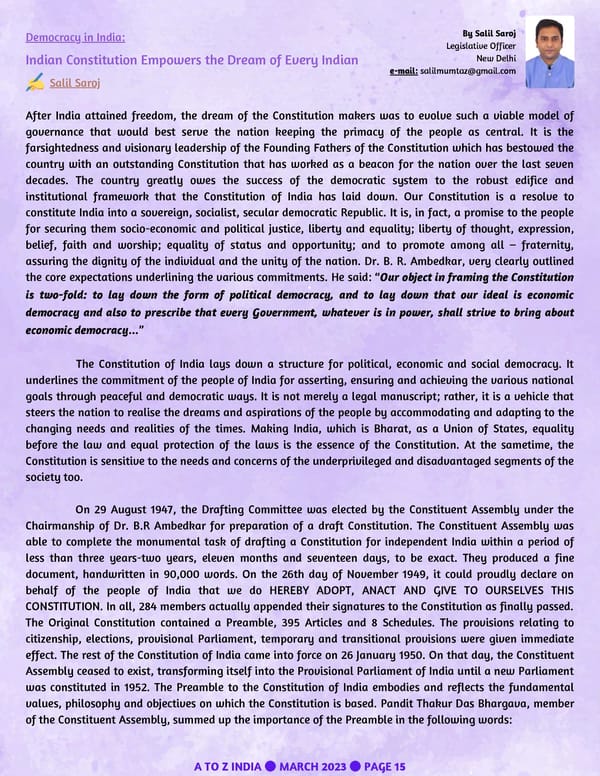By Salil Saroj Democracy in India: Legislative Officer New Delhi Indian Constitution Empowers the Dream of Every Indian e-mail: [email protected] Salil Saroj After India attained freedom, the dream of the Constitution makers was to evolve such a viable model of governance that would best serve the nation keeping the primacy of the people as central. It is the farsightedness and visionary leadership of the Founding Fathers of the Constitution which has bestowed the country with an outstanding Constitution that has worked as a beacon for the nation over the last seven decades. The country greatly owes the success of the democratic system to the robust edifice and institutional framework that the Constitution of India has laid down. Our Constitution is a resolve to constitute India into a sovereign, socialist, secular democratic Republic. It is, in fact, a promise to the people for securing them socio-economic and political justice, liberty and equality; liberty of thought, expression, belief, faith and worship; equality of status and opportunity; and to promote among all – fraternity, assuring the dignity of the individual and the unity of the nation. Dr. B. R. Ambedkar, very clearly outlined the core expectations underlining the various commitments. He said: “Our object in framing the Constitution is two-fold: to lay down the form of political democracy, and to lay down that our ideal is economic democracy and also to prescribe that every Government, whatever is in power, shall strive to bring about economic democracy…” The Constitution of India lays down a structure for political, economic and social democracy. It underlines the commitment of the people of India for asserting, ensuring and achieving the various national goals through peaceful and democratic ways. It is not merely a legal manuscript; rather, it is a vehicle that steers the nation to realise the dreams and aspirations of the people by accommodating and adapting to the changing needs and realities of the times. Making India, which is Bharat, as a Union of States, equality before the law and equal protection of the laws is the essence of the Constitution. At the sametime, the Constitution is sensitive to the needs and concerns of the underprivileged and disadvantaged segments of the society too. On 29 August 1947, the Drafting Committee was elected by the Constituent Assembly under the Chairmanship of Dr. B.R Ambedkar for preparation of a draft Constitution. The Constituent Assembly was able to complete the monumental task of drafting a Constitution for independent India within a period of less than three years-two years, eleven months and seventeen days, to be exact. They produced a fine document, handwritten in 90,000 words. On the 26th day of November 1949, it could proudly declare on behalf of the people of India that we do HEREBY ADOPT, ANACT AND GIVE TO OURSELVES THIS CONSTITUTION. In all, 284 members actually appended their signatures to the Constitution as finally passed. The Original Constitution contained a Preamble, 395 Articles and 8 Schedules. The provisions relating to citizenship, elections, provisional Parliament, temporary and transitional provisions were given immediate effect. The rest of the Constitution of India came into force on 26 January 1950. On that day, the Constituent Assembly ceased to exist, transforming itself into the Provisional Parliament of India until a new Parliament was constituted in 1952. The Preamble to the Constitution of India embodies and reflects the fundamental values, philosophy and objectives on which the Constitution is based. Pandit Thakur Das Bhargava, member of the Constituent Assembly, summed up the importance of the Preamble in the following words: A TO Z INDIA ● MARCH 2023 ● PAGE 15
 A TO Z INDIA - MARCH 2023 Page 14 Page 16
A TO Z INDIA - MARCH 2023 Page 14 Page 16